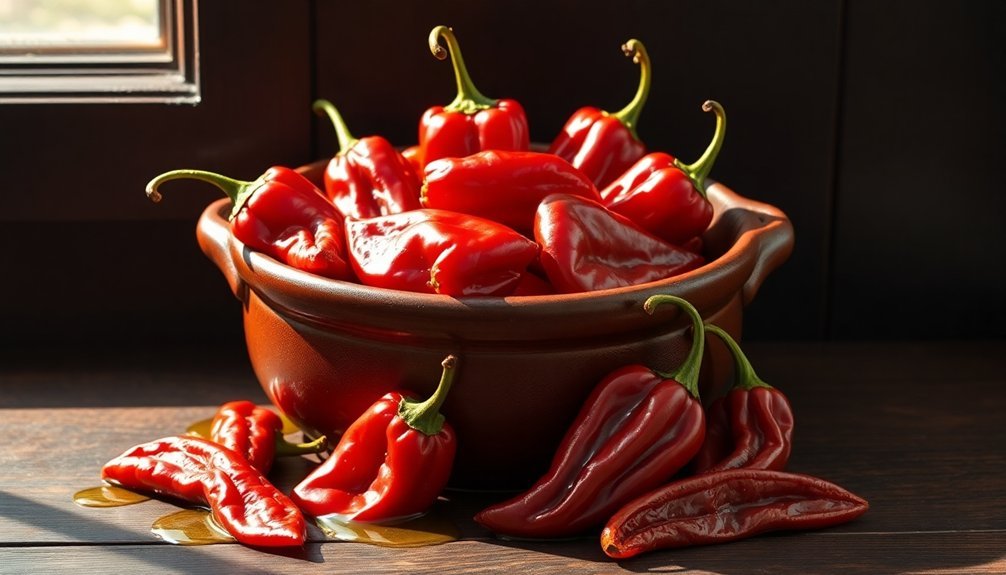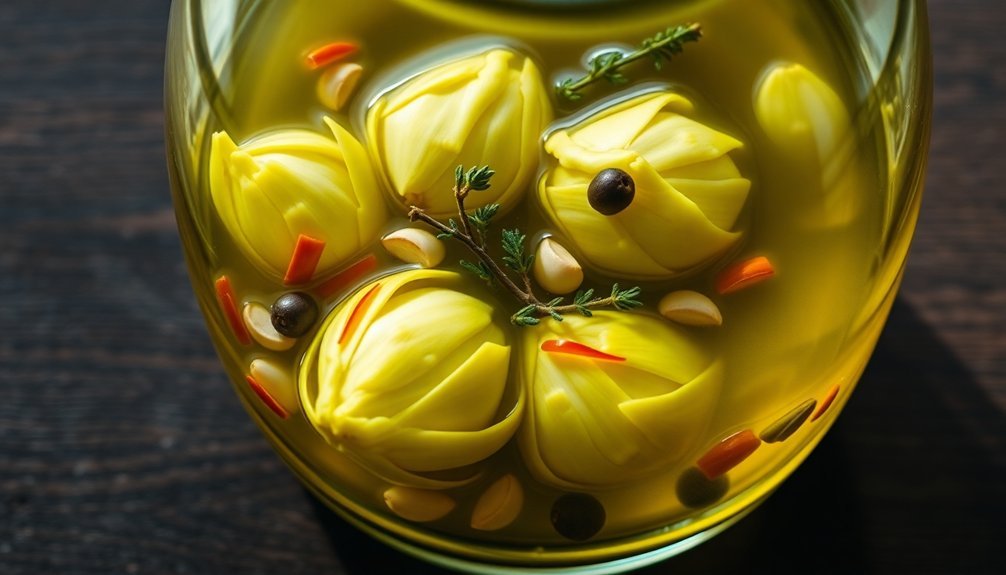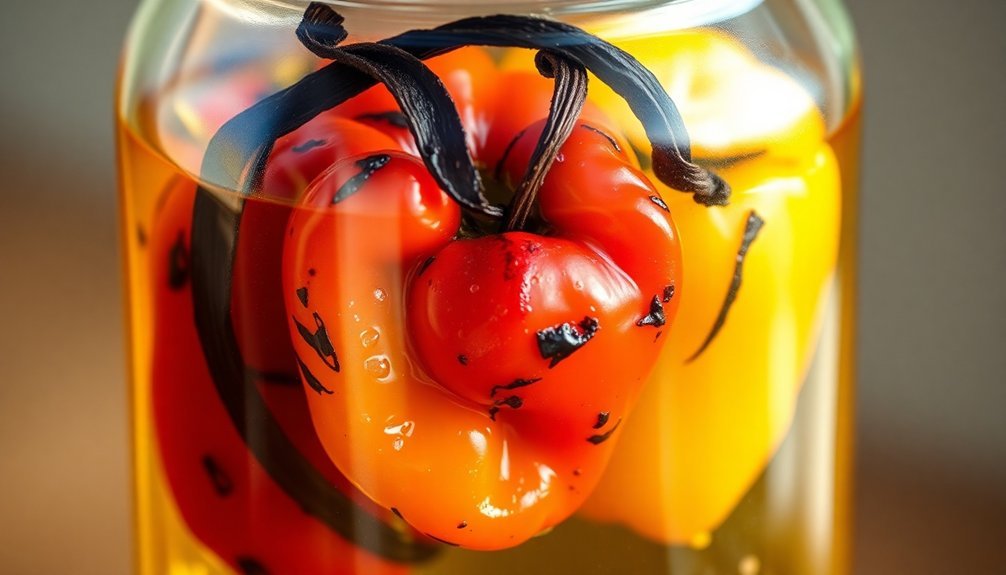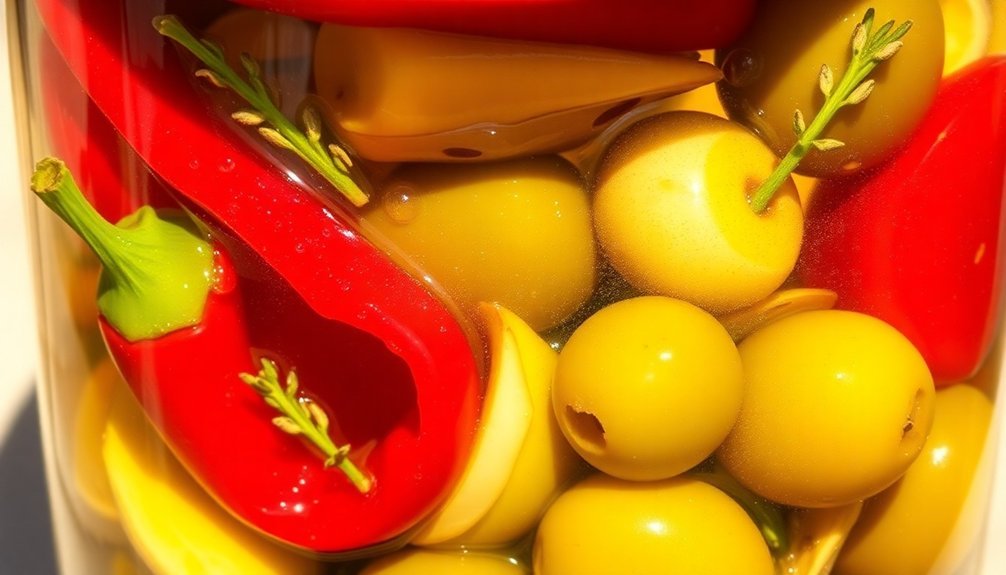Spain's most celebrated preserved vegetables feature the sweet and smoky Piquillo Peppers from Navarre, tender White Asparagus from La Rioja, and prized Tudela Artichokes. You'll also find traditional preparations of Roasted Mediterranean Eggplant, marinated with herbs and garlic, alongside Marinated Zucchini that's perfect for antipasti. Slow-Roasted Cherry Tomatoes offer concentrated flavors when stored in olive oil, while Charred Bell Peppers round out these classic Mediterranean preserves. Each vegetable brings its own distinct character to Spanish cuisine, and there's much more to discover about their preparation and uses.
Piquillo Peppers of Navarre

While many peppers claim regional significance, Piquillo peppers from Navarre stand in a class of their own. You'll find these distinctive triangular peppers exclusively in eight municipalities of Navarra, with Lodosa leading production at two million kilos annually. Traditional harvesting occurs in September when the peppers reach their optimal flavor and development. The pristine waters of the Ebro River and unique soil conditions contribute to their protected Denomination of Origin status.
You'll recognize these peppers by their deep red color, meaty flesh, and modest 2-3 inch length. They're packed with nutrients, including vitamins A and C, calcium, and antioxidants. What makes them particularly appealing is their slightly sweet, smoky flavor without any spiciness.
When you're working with Piquillos, you'll discover they're incredibly versatile. They're most commonly preserved in olive oil and can be served hot or cold. You can stuff them with bacalao, tuna, or cheese for traditional tapas, sauté them with garlic, or incorporate them into sauces.
Their thick flesh holds up well to various cooking methods, and their preserved form maintains both flavor and texture. Whether you're creating simple appetizers or complex main dishes, these peppers add authentic Spanish character to your cooking.
White Asparagus From La Rioja
Another Spanish treasure preserved in olive oil comes from the fertile lands of La Rioja – their prized white asparagus. These delicate spears, often called "White Gold," are cultivated using traditional, labor-intensive methods where farmers mound soil around the growing stalks to prevent sunlight exposure, maintaining their pristine white color.
You'll find these premium asparagus spears carefully hand-selected and preserved in jars, typically containing 6-8 thick, tender pieces weighing about 345g. The preservation process uses a special brine solution that maintains their fresh, delicate flavor and characteristic sweetness. The asparagus features an earthy undertone profile that makes it exceptionally versatile in cooking.
When it's time to serve, you've got plenty of options. Enjoy them chilled with a simple dollop of mayonnaise or vinaigrette in true Spanish style, or incorporate them into sophisticated dishes like risottos and pasta.
They're equally delicious in Spanish-inspired salads paired with tuna, white beans, and prosciutto, or as elegant toppings for pizzas and bruschetta.
These asparagus spears, protected by Denomination of Origin status, come from plants that are several years old – a requirement for producing the thick, high-quality spears that La Rioja is famous for.
Tudela Artichokes in Oil

You'll find Tudela artichokes harvested in the early morning hours near their processing facilities, ensuring ideal freshness and quality from field to jar.
These prized vegetables thrive in alluvial plains near Rivers Ebro, Ega, and Aragón where they grow in calcium-rich soil. These vegetables go through a meticulous manual selection process, where workers choose intermediate-quality artichokes and carefully peel them by hand.
Each artichoke heart is then preserved using a simple combination of water, salt, and a touch of ascorbic acid, letting the vegetable's natural characteristics shine through without the need for citric acid.
Harvesting and Selection Process
The art of harvesting Tudela artichokes follows a precise schedule that maximizes their quality and flavor. You'll find the first harvest beginning in mid-October, continuing until December's first frosts, with a second budding period from February through June. The plants are harvested every six to seven days, thriving in temperatures between 15-18°C.
When you're selecting Tudela artichokes, you'll need to check that they're firm and tight, picking them before they flower. You won't want any that have started flowering or grown too large, as they won't meet the quality standards. The Blanca de Tudela variety is particularly prized for its unique texture and canning suitability, though you'll notice more hairs developing on the artichokes as temperatures rise above 25°C.
You'll find these artichokes growing in well-drained, calcium-rich soil across the alluvial plains of the Rivers Ebro, Ega, and Aragón. The region's climate, with cold winters and mild summers, creates the perfect conditions for producing high-quality artichokes.
You can identify prime specimens by their rounded form and distinctive circular orifice where the leaves don't fully close the flowerhead.
Traditional Preservation Methods
Steeped in centuries of tradition, Spanish preservation methods for Tudela artichokes have evolved from ancient oil-immersion techniques to modern sterilization processes.
While early preservationists relied on simple methods like submerging foods in olive oil, animal fats, or vinegar, Spain's preservation techniques took a revolutionary turn in the late 18th century with the introduction of hermetic canning and glass jars.
You'll find that Spain's pioneering role in modern food preservation is evident in these key developments:
- Spain became one of Europe's early adopters of new preservation methods
- The country's first vegetable preserve factory opened in 1880
- Louis Pasteur's research on microbes greatly influenced Spanish preservation techniques
- Traditional oil-based preservation methods were refined and standardized
- The combination of ancient and modern techniques created today's superior products
Today's preservation process for Tudela artichokes reflects this rich heritage, combining traditional oil-based methods with modern food safety standards.
You'll notice that artichokes are now slowly confited in premium Extra Virgin Olive Oil, ensuring both preservation and enhancement of their natural flavors.
This method has helped establish Spanish preserved vegetables as sought-after products in international markets.
Roasted Mediterranean Eggplant
Roasting Mediterranean eggplant transforms this humble vegetable into a richly flavored dish that's perfect for storing in olive oil.
You'll want to start by scoring two medium eggplants in a diamond pattern, which helps them absorb the flavorful marinade. Create a marinade using olive oil, fresh herbs, garlic, lemon zest, juice, cumin, sea salt, and crushed red pepper.
Preheat your oven to 400-450°F and line a baking sheet with parchment paper. After arranging the eggplant slices, brush them generously with the marinade.
You'll need to roast them for 20-40 minutes, turning the pan halfway through, until they're tender but not mushy. If you'd like, add a drizzle of tahini or balsamic vinegar before serving.
For storage, you've got options. When completely submerged in olive oil, your roasted eggplant can last several months.
Without oil, store it in an airtight container in the fridge for up to 5 days, but don't freeze it as it'll become watery.
When you're ready to serve, reheat at 350°F for 8-10 minutes, and adjust the seasoning to taste.
Marinated Zucchini With Garlic

Simplicity shines through in marinated zucchini with garlic, a Mediterranean favorite that's both versatile and flavorful. You'll need two medium zucchinis, quality olive oil, white vinegar or lemon juice, and fresh garlic to create this classic dish.
Start by slicing your zucchini thinly or in quarters lengthwise, then salt them and let them stand for 30 minutes to release excess moisture.
Once you've pressed out the liquid, prepare your marinade and combine it with the zucchini. For the best results, let it marinate for at least 20 minutes, though overnight works even better. Store your creation in an airtight container, and it'll keep fresh for up to a week in the fridge.
Serve your marinated zucchini in various ways:
- Alongside grilled meats like salmon or lamb
- Mixed into quinoa or green salads
- Atop crusty Italian bread as bruschetta
- Combined with cold cuts and cheese
- As a vibrant side dish garnished with fresh herbs
Don't worry if your olive oil becomes cloudy in the fridge – it's perfectly normal and won't affect the taste.
This dish brings Mediterranean flavors to your table while maintaining its authentic charm.
Slow-Roasted Cherry Tomatoes
These tender, slow-roasted cherry tomatoes transform into sweet, concentrated morsels of flavor after a gentle cooking process in the oven.
You'll need to start by selecting uniform cherry or grape tomatoes, then toss them with high-quality extra virgin olive oil, minced garlic, and your choice of herbs like thyme, rosemary, or oregano.
Arrange your tomatoes in a single layer on a baking sheet, cut side up if you've halved them. Roast them at a low temperature between 220-275°F for 2-3 hours until they're wrinkled but still slightly juicy in the center.
For extra depth, you can add a splash of balsamic vinegar or a pinch of sugar before roasting.
To preserve your roasted tomatoes, store them submerged in olive oil in an airtight container. They'll keep in the refrigerator for up to two weeks, or you can freeze them for 3-6 months.
You'll find countless ways to use these versatile gems – top your pasta or risotto, enhance your pizzas, create flavorful bruschetta, or add them to soups and stews.
For the longest shelf life, remove any garlic and herbs before storing.
Charred Bell Peppers

From among all Spanish vegetables, charred bell peppers stand out as a versatile pantry staple.
You'll want to start by roasting them under the broiler, first coating them with olive oil on a foil-lined tray. As they char, rotate them until they're blackened on all sides, typically taking about 5 minutes.
Once they're done, you'll steam them in a zip-lock bag or covered bowl to make peeling easier.
For the best results in storing your charred peppers, you've got several options depending on how long you need to keep them:
- Store them in an airtight container in the fridge for up to 6 days, or extend this to 2 weeks by adding extra oil and pepper juices
- Create a vinegar-oil preservation method using mineral salt and leaving proper headspace for up to 2 months
- Freeze them in airtight containers or freezer bags for long-term storage
- Keep them in the refrigerator topped with olive oil to prevent air exposure
- Monitor for any signs of spoilage and discard if mold appears
Remember not to rinse the peppers after peeling, as this preserves their rich, roasted flavor.
When storing with oil, always verify proper sealing to maintain freshness and prevent contamination.
Frequently Asked Questions
How Long Can Homemade Olive Oil-Preserved Vegetables Last Before Going Bad?
You'll get 3-4 weeks when refrigerated if using fresh ingredients, but you can extend this to 1-2 months with cooked vegetables. If you freeze them, they'll last several months without going bad.
Can You Reuse the Olive Oil After the Vegetables Are Consumed?
You can reuse the olive oil after consuming the vegetables, but you'll want to strain it and use it quickly. While it may have absorbed flavors, it's still safe and economical for cooking purposes.
Which Type of Olive Oil Works Best for Preserving Spanish Vegetables?
You'll want to use Picual olive oil for preserving vegetables since it's highly stable and rich in antioxidants. Its bold flavor and long-lasting properties make it ideal for preservation techniques.
Is It Necessary to Sterilize Jars When Preserving Vegetables in Olive Oil?
Yes, you'll need to sterilize your jars before preserving vegetables in olive oil. It's essential to prevent harmful bacteria growth and guarantee food safety. Don't skip this step, as contaminated jars can cause spoilage.
What Causes Preserved Vegetables to Float Above the Olive Oil Level?
Your vegetables float when they're not fully submerged, contain trapped air bubbles, or weren't packed tightly enough. Poor oil-to-vegetable ratios and improper drying of vegetables before storing can also cause floating.
In Summary
You'll find these seven Spanish vegetables preserved in olive oil are essential pantry staples for Mediterranean cooking. Whether you're creating tapas, adding depth to salads, or building flavorful sandwiches, they're ready to enhance any dish. Keep them on hand, and you'll always be prepared to bring authentic Spanish flavors to your table. They're perfect for both planned meals and impromptu entertaining.





Leave a Reply